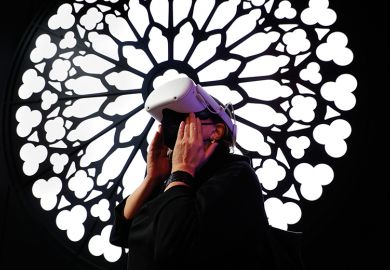“If you dropped a surgeon from the 16th century into a modern-day operating theatre, they would be astounded at how medicine had advanced,” a former vice-chancellor explained to me recently. “If you dropped a 16th-century academic into a modern-day university, they would wonder why so little had changed.”
It may be cute and reductive, but this analogy made sense to an outsider like me, who has spent the past year working with universities online as both a student and a professor.
What struck this outsider most was how old-school university learning platforms feel compared to everyday digital experiences, and how little academic content has adapted after 30 years of the web.
I am a digital technology and content expert without the qualifications or research track record of my academic colleagues. My professional work ranges from writing for the New York Times to building video-streaming services for British broadcasters and serving on the boards of digital health, education and technology companies, though it is my experience as an online student that is most pertinent here.
In a world where we have become accustomed to beautiful, frictionless, personalised digital experiences, most online education I sampled looked closer to the websites we were building in the 1990s.
THE Campus resource: Effective digital course design guide by four experts
“Academics aren’t content creators and it’s regressive to make them so” was the title of a piece by UNSW academic David Kellermann on this site earlier this month. “Universities turned from communities of learning and collaboration into B-grade content providers. This is the death march of higher education,” he wrote.
The death march begins, in my opinion, if universities do not become A-grade content aggregators and creators, integrating the best of technology and adapting pedagogy to keep pace with student expectations. Competitors ready to meet students’ demands include Apple, Google and Amazon, every international university redesigning for online, digital educational entrepreneurs and in-house academies from corporates.
Academics can’t create all the content and should not be (badly) editing video of their lectures, as Kellermann rightly notes. They need the support of content professionals. Academics, though, should be expertly guiding the translation of teaching into online standalone content (this does not mean editing or repurposing lectures), overseeing the aggregation of third-party content, leading collaborative learning and provoking discussions and debate.
For our Master of Digital Marketing at the University of Technology Sydney (UTS), course director Kaye Chan and I incorporated the academic approach and the applied industry view in an up-to-date context. Sometimes, an article from The Economist or a TED talk was a better asset than a citation of academic research − not surprising in such a dynamic topic.
THE Campus resource: UX for teaching from a student’s point of view
Of the 50 courses I sampled last year, the one that looked most like the future was from NYU Stern professor, author and tech entrepreneur Scott Galloway’s Section4. Professor Galloway uses top professors from the best US universities to deliver business strategy courses relevant to the digital economy. Here are four lessons for online education from his courses:
Design for your audience
Professor Galloway is targeting a business audience that wants to upskill in tech, innovation and strategy but is time poor. Prof G, as he is known, gives a fast-talking breakdown of tech, finance and customer strategy, presents original insights and great analysis in short, pithy videos with accompanying articles, papers and other assets for those who want to dive deeper. As a media-savvy educator, Professor Galloway’s talent in front of a camera is beyond most academics, but we can all learn from the brevity and scripting of the videos.
Quality counts
The design, storytelling and animation are professional and engaging (as one would expect from a professor of marketing), and the case study selection is as good as you would find in many MBAs. High-quality videos, clear sound and original graphics and animation create a coherent, slick brand and an experience that wraps around quality content.
Build around access to professors and facilitators
Weekly live sessions with Professor Galloway include a presentation on a topic and live video questions from students. These were presented from a purpose-built, professional studio with well-designed graphics. Expertly moderated, they felt remarkably intimate even though they often included more than 500 students.
Build the community
Deliberate curation of the community into study groups by geography, discussion groups by sector interest and teams for project work was facilitated by teaching assistants and done ahead of the course starting. For professional courses, where networking is part of the appeal, being particularly careful about how to replicate the in-person experience with networking options is a key feature.
Interaction with students in live seminars, synchronous forums and virtual office hours have worked well for our master programme at UTS, and many other courses similar to Section4’s, to create connection and cohesion among the student cohort and academics.
The design, content and production values of these Section4 courses were superior to any other university or independent content I sampled. Many of these observations may be viewed dimly by academics, but most instructive for anyone interested in the future of higher education is the value delivered – at $750 (£538) for a four-week course, this was the best-quality online course out of the dozens I took last year, some of which were priced at 50 times that amount.
Louise McElvogue co-designed UTS Business School’s Master of Digital Marketing (online) course as an industry professor and is founder of upskilling course provider With Fluency. She serves on a range of listed and government boards in health, technology and education.
Register to continue
Why register?
- Registration is free and only takes a moment
- Once registered, you can read 3 articles a month
- Sign up for our newsletter
Subscribe
Or subscribe for unlimited access to:
- Unlimited access to news, views, insights & reviews
- Digital editions
- Digital access to THE’s university and college rankings analysis
Already registered or a current subscriber? Login








